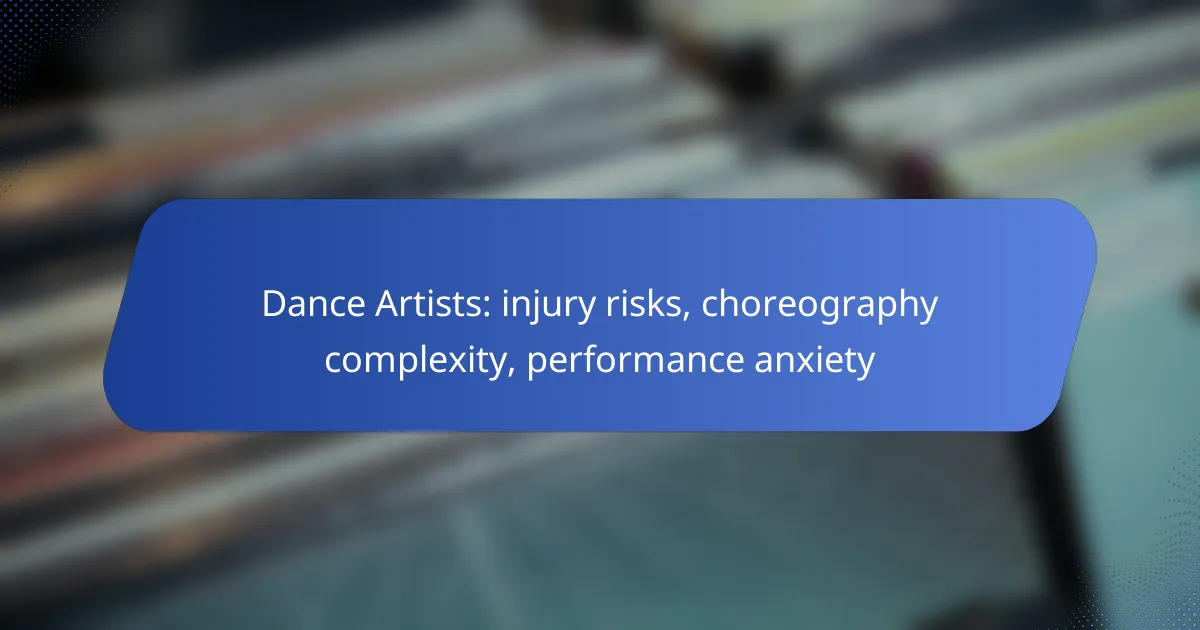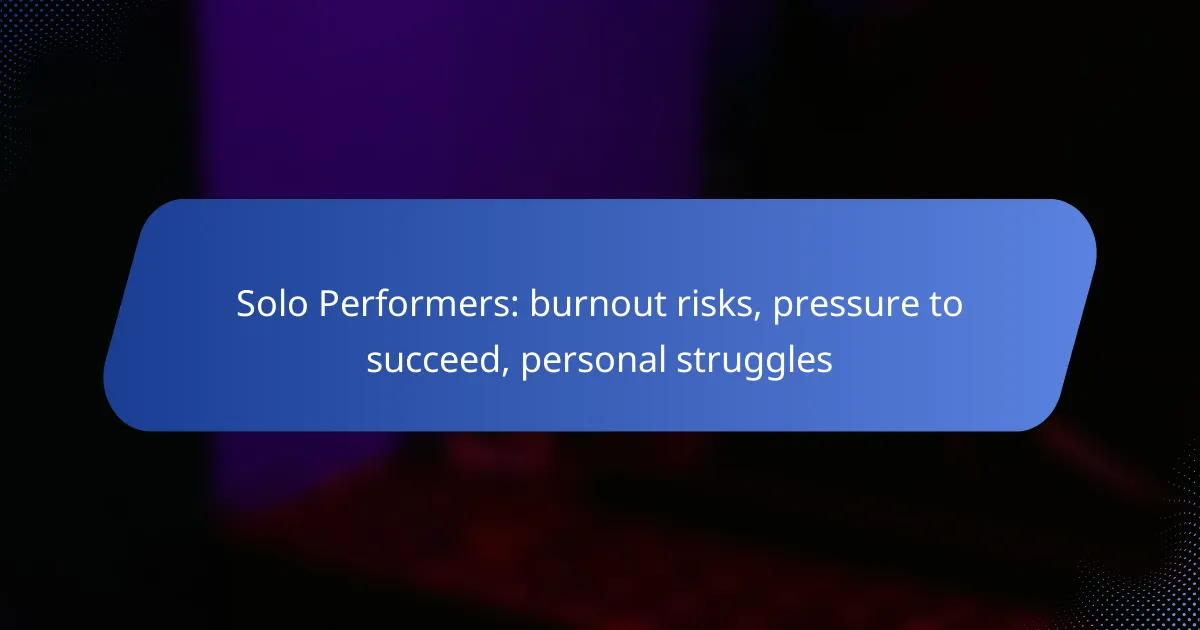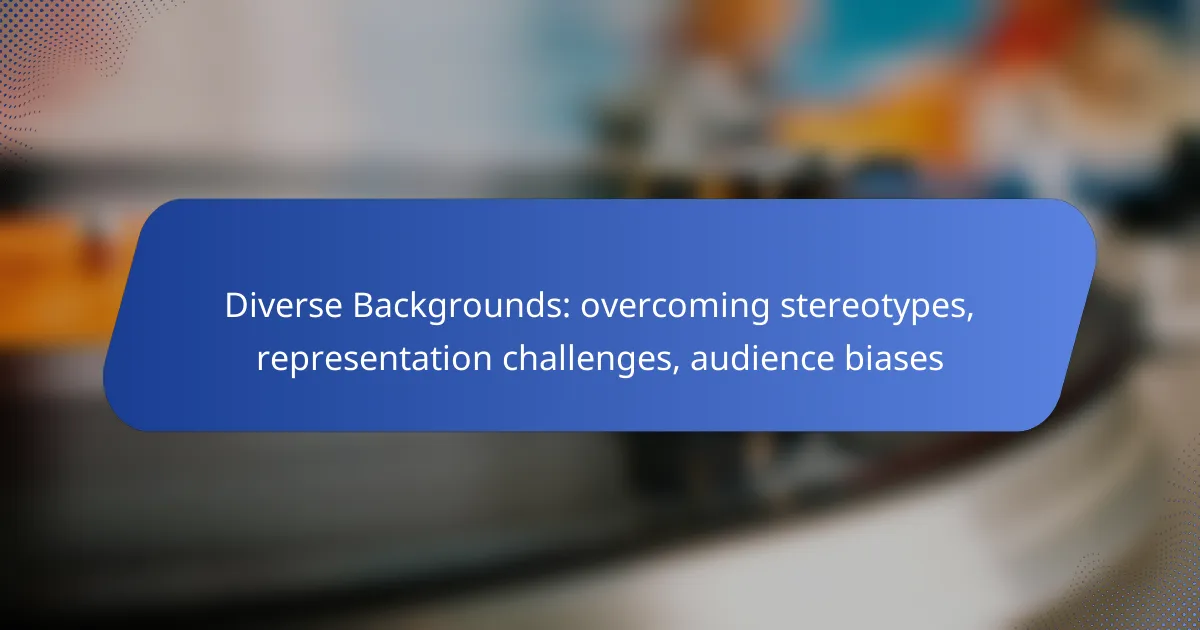Dance artists navigate a unique landscape filled with injury risks, stemming from the physical demands of their craft, including repetitive movements and high-impact landings. Additionally, the complexity of choreography adds another layer of challenge, requiring intricate coordination and mastery of various dance styles. To combat performance anxiety, dancers can employ mental techniques and preparation strategies, fostering both enhanced performance and overall well-being.

What are the injury risks for dance artists?
Dance artists face various injury risks due to the physical demands of their art form. Common injuries often stem from repetitive movements, high-impact landings, and inadequate warm-up routines.
Common injuries in dance
Dance artists frequently experience injuries such as sprains, strains, and stress fractures. Ankle sprains are particularly common due to the nature of dance movements that involve jumping and landing. Other prevalent injuries include tendonitis, especially in the knees and hips, as well as lower back pain.
Injuries can vary based on the dance style; for instance, ballet dancers may suffer from foot and ankle issues, while hip-hop dancers might face more knee and lower back injuries. Understanding these common injuries can help artists take proactive measures to protect themselves.
Factors contributing to injuries
Several factors contribute to the injury risks faced by dance artists, including inadequate training, poor technique, and insufficient rest. Dancers often push their bodies beyond safe limits, leading to overuse injuries. Additionally, a lack of proper footwear or unsuitable performance surfaces can increase the likelihood of injury.
Environmental factors, such as temperature and humidity, also play a role. Cold or damp conditions can lead to muscle stiffness, making injuries more likely. Dancers should be mindful of these factors and adjust their practices accordingly.
Preventative measures for injuries
To minimize injury risks, dance artists should incorporate a comprehensive warm-up routine that includes stretching and strength-building exercises. Regular cross-training can also enhance overall fitness and reduce the risk of overuse injuries.
Maintaining proper technique is crucial; dancers should seek feedback from instructors and consider video analysis to identify and correct any flaws. Finally, ensuring adequate rest and recovery time is essential for preventing injuries and maintaining peak performance.

How can dance artists manage performance anxiety?
Dance artists can manage performance anxiety through a combination of mental techniques, preparation strategies, and support networks. By addressing anxiety proactively, dancers can enhance their performance and overall well-being.
Techniques to reduce performance anxiety
Several techniques can help dancers alleviate performance anxiety. Deep breathing exercises, visualization, and mindfulness practices are effective methods to calm nerves before a performance. Engaging in regular physical activity can also help reduce overall anxiety levels.
Additionally, rehearsing in front of small, supportive audiences can build confidence and familiarity with performing. Dancers might also consider keeping a journal to track their feelings and progress, which can provide insights into their anxiety triggers.
Role of mental preparation
Mental preparation is crucial for managing performance anxiety. Setting realistic goals and focusing on the process rather than the outcome can help dancers maintain a positive mindset. Techniques such as positive self-talk and affirmations can reinforce confidence and reduce self-doubt.
Creating a pre-performance routine can also enhance mental readiness. This might include specific warm-up exercises, listening to motivating music, or engaging in visualization techniques to mentally rehearse the performance.
Support systems for dancers
Having a strong support system is vital for dancers dealing with performance anxiety. This can include mentors, fellow dancers, and mental health professionals who understand the unique pressures of performing. Open communication within these networks can foster a sense of community and shared experience.
Dancers should not hesitate to seek professional help if anxiety becomes overwhelming. Therapists specializing in performance anxiety can provide tailored strategies and coping mechanisms. Regular check-ins with peers can also help dancers feel less isolated in their experiences.

What is the complexity of choreography?
The complexity of choreography refers to the intricacy and difficulty of dance movements and sequences. It encompasses various elements such as the number of steps, the coordination required, and the interplay of different dance styles.
Factors influencing choreography complexity
Several factors contribute to the complexity of choreography, including the dancer’s skill level, the style of dance, and the intended emotional expression. For instance, advanced dancers may incorporate intricate footwork and complex rhythms, while beginners might stick to simpler patterns.
Additionally, the use of props, formations, and transitions can significantly increase complexity. Choreographers must balance these elements to create a piece that challenges dancers while remaining accessible to the audience.
Examples of complex choreography styles
Styles such as contemporary, ballet, and jazz often feature complex choreography. Contemporary dance may include unexpected movements and floor work, while ballet relies on precise technique and intricate foot patterns. Jazz can blend various styles, adding layers of complexity through syncopation and improvisation.
Other genres, like hip-hop and tap, also showcase complexity through rapid footwork and intricate body isolations. Each style presents unique challenges that require different skill sets and training approaches.
Impact of complexity on performance
The complexity of choreography can significantly impact a dancer’s performance. High complexity often demands greater physical and mental focus, which can lead to performance anxiety if not managed properly. Dancers may struggle with memorization and execution, especially under pressure.
However, when executed well, complex choreography can captivate audiences and elevate a performance. Dancers should practice extensively and develop coping strategies to handle the challenges posed by intricate routines.

What are the best practices for injury prevention in dance?
To prevent injuries in dance, it is essential to incorporate proper warm-up and cool-down routines, engage in cross-training, and follow safe practice guidelines. These practices help maintain physical health, enhance performance, and reduce the risk of injuries.
Importance of warm-up and cool-down
Warm-up and cool-down routines are crucial for preparing the body for dance and aiding recovery afterward. A good warm-up increases blood flow to muscles and enhances flexibility, while a cool-down helps to gradually lower heart rate and prevent stiffness.
Typically, a warm-up should last around 10-15 minutes and include dynamic stretches and movements specific to the dance style. Similarly, a cool-down should involve gentle stretching and relaxation techniques for about 5-10 minutes.
Role of cross-training
Cross-training involves participating in different physical activities to improve overall fitness and reduce the risk of injury. For dancers, this can include activities like swimming, yoga, or Pilates, which enhance strength, flexibility, and cardiovascular endurance.
Incorporating cross-training into a weekly routine can help dancers develop complementary skills and prevent overuse injuries by balancing muscle development. Aim for 1-2 sessions of cross-training each week to maintain a well-rounded fitness level.
Guidelines for safe practice
Safe practice guidelines are essential for minimizing injury risks. Dancers should always listen to their bodies, avoid pushing through pain, and ensure they are using proper technique during rehearsals and performances.
- Stay hydrated and maintain a balanced diet to support energy levels.
- Use appropriate footwear and dance surfaces to reduce impact stress.
- Set realistic goals and gradually increase the intensity of training.
Regularly consulting with a dance instructor or physical therapist can provide personalized insights and adjustments to enhance safety during practice.

How does choreography complexity affect injury risk?
Choreography complexity significantly impacts injury risk for dancers. More intricate routines often require advanced skills and physical demands, which can lead to a higher likelihood of injuries if not managed properly.
Correlation between complexity and injuries
Research indicates that as choreography becomes more complex, the risk of injuries tends to increase. Dancers performing intricate movements may experience strains, sprains, or overuse injuries due to the heightened physical demands placed on their bodies.
For example, routines that incorporate rapid changes in direction, jumps, or turns can lead to ankle and knee injuries. Dancers should be aware that higher complexity often correlates with a need for greater strength and flexibility training to mitigate these risks.
Choreography adjustments for safety
To reduce injury risks associated with complex choreography, adjustments can be made to routines. Simplifying certain movements or incorporating rest periods can help dancers maintain their performance levels while minimizing strain.
Additionally, using proper warm-up techniques and cooldowns is essential. Dancers should focus on building strength in key muscle groups and improving flexibility to better handle complex choreography without injury.
Regular assessments of a dancer’s physical capabilities can also guide choreographers in creating safe routines that challenge without overwhelming the performer.

What emerging trends are shaping dance performance?
Emerging trends in dance performance are significantly influenced by technological advancements, evolving choreography complexity, and a growing awareness of performance anxiety. These factors are reshaping how dancers train, perform, and connect with audiences, leading to innovative expressions in the art form.
Technological advancements in dance
Technological advancements are revolutionizing dance performance by enhancing choreography and audience engagement. Tools such as motion capture and augmented reality allow choreographers to create intricate movements and visualize performances in new ways.
For instance, wearable technology can monitor a dancer’s physical condition, providing real-time feedback on performance metrics like heart rate and muscle strain. This data helps dancers optimize their training and reduce injury risks.
Additionally, platforms for virtual performances have gained traction, enabling artists to reach global audiences without geographical constraints. This shift not only broadens exposure but also introduces new revenue streams through online ticket sales and streaming services.










